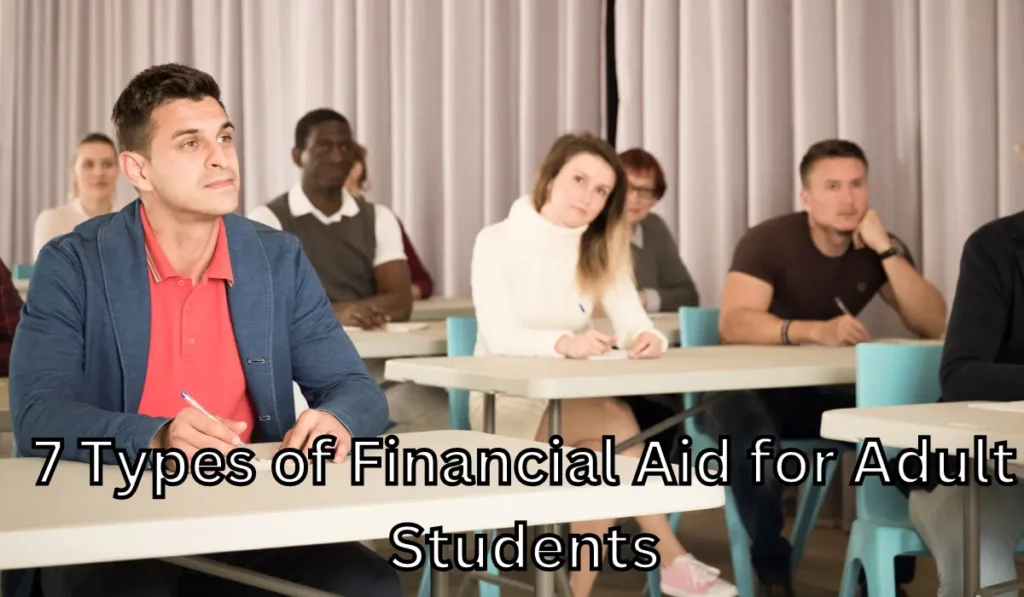Education, regardless of age, is an investment in yourself. However, financial constraints prevent many from pursuing their dreams, especially if you’re an adult student returning to school.
Depending on the institution, the average cost of college tuition ranges from $26,000 to $56,000 per academic year, making it difficult for many students to pay for their education.
However, different types of financial assistance for returning students are available to mitigate the overall cost or completely take care of tuition.
Understanding the different types of grants, scholarship and loans for adult students can initially seem complex. Therefore, I have summarized them in simple and clear terms for you to understand the steps needed to get financial aid for your college degree.
Types of Financial Aid for Non-traditional Adult Students
Before we go ahead and break down every possible financial aid for Non-traditional students, let’s identify the available options –
- Scholarships
- Grants
- University Employment
- Employer-Sponsored Aid
- University Financial Programs
- Community and Local Organization’s Support Programs
- Student Loans
Scholarships for Adult Students
One of the ways to tackle your financial limitations as an adult student is through scholarships. There are two types of scholarships that you can opt for –
- Government Funded Scholarships
- Private Scholarship Programs
Let’s give you the details –
A. Government Funded Scholarships
Typically, these types of scholarships come directly from the government. They are awarded to assist students in need and to ensure that talented individuals realize their full potential without financial constraints.
Government-funded scholarships are divided into two parts –
Federal Scholarship Support
This requires you to provide the necessary documents and meet specific criteria before you can get any support. You need to fill out FAFSA and check different types of federal student aid to determine your eligibility.
To search for scholarships, you can use various scholarship search engines, including wemakescholars.com and scholarships.com.
State Scholarship
The State scholarship awards students different types of scholarships and grants based on their need and qualifications. Moreover, the type of financial support and scholarship differ from one state to another.
Consult your state higher education agency or local scholarship search engines to determine your eligibility for state financial support and scholarships.
Thereafter, contact the state scholarship offices and follow the necessary procedures required to complete your scholarship applications.
B. Private Scholarship Programs
The eligibility requirements for private and institutional programs depend on personal terms and whether or not you meet their criteria.
The general purpose of private scholarships is to demonstrate goodwill and help students obtain a higher education by taking care of their financial concerns.
On average, a student who receives a scholarship or grant at a private 4-year college earns more money than a student at a public 4-year college.
Grants
Aside scholarships, you should apply for grants. You can opt for federal or private grants, considering you meet their requirements.
There are seven federal grants out there including
- Pell Grant
- TEACH Grant
- FSEOG Grant
- Federal Work-Study Program
- STEM Grant
- Iraq and Afghanistan Service Grant
- Federal Grant for Military Personnel
To apply for any of these grants, you need to submit your FAFSA, which is entirely free. However, to meet the eligibility requirements, you must:
- be a US citizen or non-citizen with SSN validation from the US government
- have a GED certificate, high school diploma, or equivalent educational certification
- be enrolled or accepted in a certificate or degree program
- maintain sufficiently good academic progress in school
- have no criminal records of any sort
- not incur any loans or owe the government or federal agents
Furthermore, returning students receive grants from private sponsors. However, the sponsors determine the eligibility and terms of application.
University Employment
Universities and colleges allow you to study for free or require partial payment if you are enlisted as an employee at their institution. There are multiple ways you can take advantage of this approach.
You can be a full-time worker and ask to apply for a degree in your institution for free or partial payment. Research and teacher assistants are the two most common employment options for adult students who are pursuing masters or doctorate degrees.
For lifelong learners pursuing a bachelor’s degree, possible employment options include working as an accountant at the university or taking part-time jobs in campus stores.
Ensure to balance your work hours with your study hours when selecting these employment and contracts.
Most universities have this option to support their employees if they want to pursue a higher degree from their institution.
Employer-Sponsored Aid
Many companies want their employees to pursue higher degrees and will offer financial support if needed. They do this to ensure the following:
- Invest in Their Employee Development
An educated workforce is an asset, and every company realizes that it benefits both their employees and the organization.
- Retain Talented Employees
Most employer-sponsored aid is geared towards retaining employees.
Employers offer a commitment contract that binds the employee to work with the company for a certain period. This develops employee loyalty to the employer.
- Attract Talents
Companies offer tuition sponsorship to attract talented individuals and retain them once they have honed their skills through education.
As an adult student, ensure to check the employee support system regarding higher studies if a firm or company has employed you.
Therefore, check in with your HR department to confirm if you are eligible for this sort of sponsor support from your employer. You have to agree to some specific terms before you can avail yourself of this form of financial aid.
University Financial Programs
Universities often have financial programs, and mature students are not excluded.
Some of the most common financial aid programs include:
- Sports scholarships for students who have demonstrated exceptional athletic talents
- Arts & music scholarships for students who meet the institution’s portfolio requirements.
- Diversity financial programs for students representing minority groups, diverse backgrounds, and communities.
- Community service scholarships for students who have dedicated themselves to the improvement of the community and have received awards highlighting their civic engagements.
- Entrepreneur grants for students who have demonstrated their strategic and business prowess and require funding for further development.
- Foreign exchange and study abroad programs offer foreign adult students who want to be part of their academic program.
Therefore, ensure to check the financial support page or call the financial aid office of the desired university to find out if you are eligible for their programs or not.
Community and Local Organization’s Financial Support Programs
You should contact local non-profit organizations offering financial support for students to confirm if you are eligible for their support programs.
For example, local business scholarships where business associations offer charitable scholarships to support local students.
They have specific requirements such as residing in a particular or having certain subjects as AP courses.
Others include Veteran Education Assistance, Women or Minority Organizations, and Parent Support Programs, which help their respective audience and children with education support.
Student Loans
Lastly, you can opt for federal student loans or private loans as a means for your financial support. While you may be skeptical about getting in debt, keep in mind that obtaining scholarships in college is difficult.
Only one in every eight students receives scholarships. Moreover, those awarded a scholarship do not get sufficient money, as the stats show 97% of students receiving scholarships in college get less than 2,500 USD. Only 0.2% of applicants receive approximately 25k USD and 0.1% get a full ride.
In addition, approximately 58% of college students seek financial help from scholarships & grants for college tuition. Thus, you may have to opt for student loans even if you manage to gain scholarships or grants.
Students prefer private student loans because they come with additional perks and can be based on your monthly income.
You can look into some of the following federal student loan options:
- Direct subsidized loan—you have to showcase your financial need along with documents proving your US citizenship and completion of FAFSA. This is the most preferred option for students as the Department of Education handles these federal loans.
- Direct unsubsidized loan—you do not have to provide any proof of financial need; however, the documentation requirements are the same as the subsidized loans.
- Direct PLUS loan—you need to have a good credit score, be a US resident, and complete FAFSA to avail this loan.
Private loans can also be satisfactory if you are an adult who had the time to invest and now has enough financial backing to shoulder a student loan.
Some popular private lenders in this field are Wells Fargo, Discover, and Sallie Mae. Look out for the loan duration, interest rates, and any unique conditions (if any) the lender provides during selection.
You also have to be wary of the eligibility requirements, such as good credit scores, promising grades, and other factors.
How Much Financial Aid Can You Get?
The amount of financial aid depends on several factors. Private scholarships, grants, and aids are based on the terms of the sponsor or the organization that is providing the aid.
However, Federal grants have a range that applies to you depending on the following factors:
- The Cost of Attendance (COA) for your program—the amount that it will cost you to go to school throughout the period of enrolment
- Expected Family Contribution (EFC)—the amount your family is able to contribute to your education if you were to be selected for a program
- Need-based aid is provided based on the difference between COA & EFC
- Non-need-based aid is determined by subtracting COA from all other financial aid
- Amount of Financial Aid Adult Students Can Get Through FAFSA
| Name of Financial Aid | Estimated Aid (Yearly) |
| Pell | 4310$–7395$ |
| TEACH | 3772$ |
| FSEOG | 670$–4000$ |
| Federal Work-Study Program | Varies per University |
| STEM | 8000$ |
| Iraq & Afghanistan Service Grant | $6501.99$ |
| Federal Grants for Military Personnel | Varies per personnel and need |
| Direct Subsidized Loan | 3500$–5500$ |
| Direct Unsubsidized Loan | 5500$–20500$ |
| Direct Plus Loan | Total COA amount |
Keep in mind that grants and financial aid supported by the FAFSA only last for one study year. Subsequently, you have to reapply for FAFSA to approve your aid.
Final Thoughts on Federal Financial Aid for Adult Undergraduate and Graduate students
Your financial limitations should not prevent you from obtaining the desired degree; you only need to search for the various financial aid available for students and check if you are eligible. Even if you don’t receive any receive federal student aid for your age limit; don’t give up.
There are other types of grants and personal loans option for adult learners. Furthermore, age is not required for learning; thus, don’t be discouraged if you have passed the typical graduate student age.
Best of luck!






